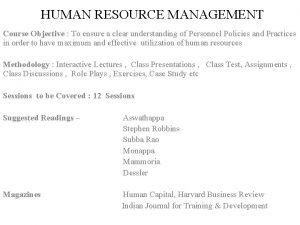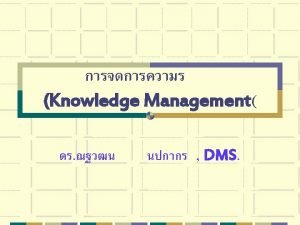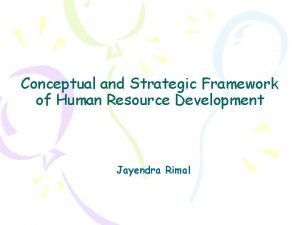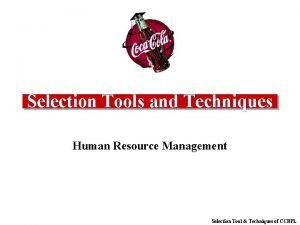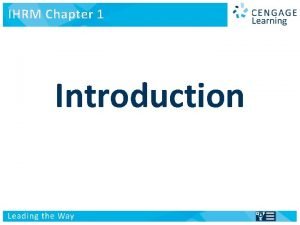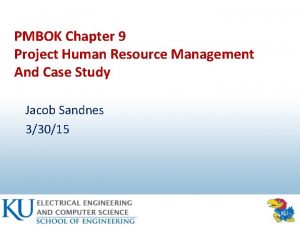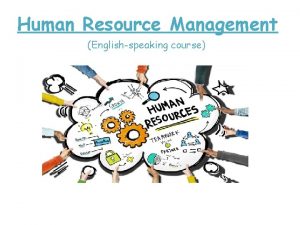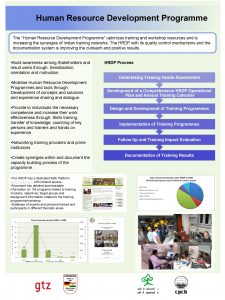Advances in Human Resource Development and Management Course























- Slides: 23

Advances in Human Resource Development and Management Course Code: MGT 712 Lecture 26

Recap of Lecture 25 • HRD Process Model • Implementing Training/ HRD Programs – Training/ HRD Delivery Methods – Learning Pyramid – Basic Training Method Classification • On-the-Job Training (OJT) • Classroom Training Lecture 26 2

Learning Objectives: Lecture 26 • Classroom Training – Case Study Method – Business Games and Simulations – Role Playing – Behavior Modeling – Outdoor Education • Computer-Based Training • Choosing a Training Method Lecture 26 3

Classroom Training The training methods discussed so far primarily focus on – Presentation of training content – The learner generally assumes to be a passive recipient of information Experientialists believe that: – Effective learning is an active experience that challenges the skills, knowledge, and beliefs of participants – Effective learning is accomplished by creating a contrived, yet realistic environment that is both challenging and psychologically safe – Learners bring to the learning environment a set of accumulated knowledge, and learning methods Types of Experiential Methods – – – Case Study Method Business Games and Simulations Role Playing Behavior Modeling Outdoor Education Lecture 26 4

Classroom Training The Case Study Method Helps trainees learn analytical and problem solving skills by presenting a story about people in an organization who are facing a problem or decision. – Cases may be real or fictional – Cases can be studied by individuals or small groups – This approach assumes that employees are most likely to recall and use knowledge and skills learned through a process of discovery – Rational problem-solving process that includes: • Identifying and restating important facts • Drawing inferences from the facts • Stating the problem or problems • Developing alternative solutions and then stating the consequences of each • Determining and supporting a course of action • Suggest what might have been done differently Lecture 26 5

Classroom Training Criticism of Case Study Method It can cause group think Focuses too much on the past Limits the teaching role of the trainer Reduces the learner’s ability to draw generalizations Reinforces passivity on the part of the learner Quantity of interaction among learners against the quality of interaction – Cases often lack realistic complexity and urgency – Trainees may caught up in the details of the situation at the expense of focusing on the larger issues and concepts – Trainees cannot question assumptions and positions taken – – – Lecture 26 6

Classroom Training Business Games and Simulations – Are designed to reproduce or simulate processes, events, and circumstances that occur in the trainee’s job, – Trainees can experience these events in a controlled setting – Are intended to develop or refine problem-solving and decisionmaking skills. – Focus primarily on business management decisions • Equipment Simulators Are mechanical devices that require trainees to use the same procedures, movements, and decision processes they would use the equipment back on the job. – Electronic sales register system Lecture 26 7

Classroom Training • Business Games Are simulations that attempt to present the way an industry, company, or unit of a company functions. – Inter Company game – Intra Company game “In-Basket” Exercise Assesses the trainee’s ability to establish priorities, plan, gather relevant information, and make decisions in allotted time. – The trainees are told that they have been promoted to a management position and are provide with background information about the organization – Trainees receive the contents of the manager’s in-basket – Trainees are then asked to read, organize, prioritize, and make decisions – Finally, trainees’ decisions are evaluated by the trained scorers Successful in improving trainee effectiveness and in predicting future managerial effectiveness Lecture 26 8

Classroom Training Role Playing In the role-playing technique, trainees are presented with an organizational situation, assigned a role or character in the situation and asked to act out the role with one or more other trainees. • • The role play should offer trainees an opportunity for self-discovery and learning – interpersonal conflict, selling situation Information regarding the situation is provided to the trainees. Provide an opportunity to practice and learn interpersonal skills The value of this technique is enhanced by conducting a feedback session following a role play The role episodes may be videotaped The more meaningful the exercise, the higher the level of participant focus and intensity. Limitations of the role paling method: – Limited scope of transferring the learning to the job site – Trainees may feel intimidated by having to act out a character – Participants may perceive it as fun and games which may interfere with others learning Lecture 26 9

Tips for Developing and Presenting Role Plays Developing Create characters carefully to prove your point. Provide two characters who are going to clash in exactly the way you want. Provide detailed background on characters’ habits, attitudes, goals, personalities, and mood, and on the business restrictions that motivate or restrain them. Presenting Take the time to introduce the situation. Give trainees enough background to understand what’s at stake; then assign the roles. Make sure participants understand your instructions if you plan to use observers to provide feedback, have each of them use an observation sheet to look for key behaviors and to respond to key aspects of the performance. After the performance, always discuss what happened. This is how learning takes place. Ask questions of each player, and have the group advise the players. Encourage discussion. Challenge them with alternatives: “What would have happened if…? ” Lecture 26 10

Classroom Training Behavior Modeling Trainees observe a model performing a target behavior correctly usually on a video or DVD. • This is followed by: – Discussion of the key components of the behavior – Practicing the target behavior through role playing – Receiving feedback and reinforcement for the behavior they demonstrate • Based on the principles of social learning theory. • More appropriate for learning interpersonal skills and behaviors than factual information. • In organizations, employees learn from observing supervisors, managers, union leaders, and coworkers who serve as role models. Lecture 26 11

Classroom Training Outdoor Education Includes work teams being involved with outdoor games, orienteering, rafting, and rope courses. – Focuses on the development of teamwork and leadership skills using structured outdoor activities – Also known as wilderness training and outdoor training. • To be successful: – Exercises should be related to the types of skills that participants are expected to develop. – After the exercises, a skilled facilitator should lead a discussion about • • What happened in the exercise? What was learned? How events in the exercise relate to job situation? How to apply what was learned on the job Lecture 26 12

Classroom Training Outdoor Education – Best suited for developing skills related to group effectiveness such as: – Self-awareness – Problem solving – Conflict management – Risk taking – HRD professionals should ensure that proper assessment and evaluation are included in any such program Lecture 26 13

Computer-Based Training Computer-based training trains employees using computer-assisted instructions. – A general term referring to the training provided in part or whole through the use of a computer. – Conducted using either a classroom or an individual self-paced format – Can be almost limitless interplay between instructor-led and individual -based computer training Paper Based Self-Paced Training – Before 1980 s most self paced training was paper based. – Culture assimilator training for American traveling to particular countries – Trainees read various descriptions of another culture and then make choices – Each response directed the trainee to a particular page in the work book Lecture 26 14

Computer-Based Training • Primary advantage CBT has over other methods of training is its interactivity – Mirrors the one-on-one relationship between student and tutor – Provides for immediate feedback – Well-suited to on-demand learners • Three approaches – Computer-Aided Instruction (CAI) – Intranet training – Intelligent CAI Lecture 26 15

Computer-Based Training Computer-Aided Instruction Range from electronic workbooks using Drill and practice approach to CD-ROM presentations of traditional training programs. – Teach basic skills like Math, Reading, typing – Teach highly technical skills – Many programs include interactive tutorials • Microsoft® Office programs – Multimedia programs provide more appealing visual and audio content – Many companies have replaced instructor-led courses with CD-ROMs Lecture 26 16

Computer-Based Training Advantages of Computer-Aided Instruction • In an interactive CAI - based on trainee responses - computer presents various levels of material until trainee reaches mastery • Allow trainees to control the speed of instruction and makes them selfsufficient learners • More accessible to learners through variety means of distribution • Automated Instructional management and tracking learner progress Effectiveness can be measured through: • Increase in productivity and profits • Cost and benefit analysis • Takes less time to learn the same amount of material Criticism • Lacks a personal interaction • May not develop interpersonal skills • May not be suited to unmotivated learners Lecture 26 17

Computer-Based Training Intranet-based Training (IBT) • Intranet are computer networks that use advance technology for finding, managing, creating, and distributing information within one organization. • Intranet based training (IBT) uses internal computer networks for training purposes. • HRD Professionals can: – – communicate with learners conduct needs assessment and other administrative tasks transmit course materials, training documents, and multimedia programs administer tests • IBT is powerful delivery system for multinational spread out across the globe. • IBT has the features of a multimedia CD-ROM program plus the capability of users to communicate quickly • It has certain limitation that mostly pertain to IT • It pushes the time for learning to the employees’ non work or off time Lecture 26 18

Computer-Based Training Intelligent Computer-Assisted Instruction (ICAI) • • • It goes beyond CAI in terms of flexibility and the ability to qualitatively evaluate the learner performance. It provides some of the primary characteristics of a human tutor. Intelligent tutoring systems able to determine the learner’s capability from – the learner’s response patterns – by analyzing the learner’s errors It makes teacher more available for more creative endeavors Based on “Artificial Intelligence – which involves engineering some aspects of the human thought process. In evolutionary development in government, military and industry Lecture 26 19

Choosing a Training Method Identify the type of learning outcome that you want training to influence. 2. Consider the extent to which the learning method facilitates learning and transfer of training. 3. Evaluate the costs related to development and use of the method. 4. Consider the effectiveness of the training method. 1. Lecture 26 20

Summary of Lecture 26 • Classroom Training – Case Study Method – Business Games and Simulations – Role Playing – Behavior Modeling – Outdoor Education • Computer-Based Training • Choosing a Training Method Lecture 26 21

Reference books Effective Training: Systems, Strategies, and Practice (3 rd Ed. ) P. Nick Blanchard and James W. Thacker: Dorling Kindersley, Delhi Human Resource Development: Foundation, Framework and Application Jon M. Werner and Randy L. De. Simone: Cengage Learning, New Delhi Lecture 26 22

Thank you! Lecture 26 23
 Human resource management course objectives
Human resource management course objectives Time management human resources
Time management human resources Assess human resource requirements of a retail organization
Assess human resource requirements of a retail organization Management is universal and everywhere
Management is universal and everywhere Bhrod rpms
Bhrod rpms Human resource development framework
Human resource development framework Human resources management final exam
Human resources management final exam Human resource development council of south africa
Human resource development council of south africa Hr practices in nepal
Hr practices in nepal Hr strategy map
Hr strategy map Conceptual framework of human resource development
Conceptual framework of human resource development Strategic human resource
Strategic human resource Human resources and job design
Human resources and job design Payroll cycle activities
Payroll cycle activities Selection in human resource management
Selection in human resource management Human resource management tools and techniques
Human resource management tools and techniques International human resource planning
International human resource planning Taly payroll
Taly payroll What is long term loans and advances
What is long term loans and advances Lurbinectedin posologie
Lurbinectedin posologie Cna chapter 8 human needs and human development
Cna chapter 8 human needs and human development Chapter 8 human needs and human development
Chapter 8 human needs and human development Resource management pmp
Resource management pmp Pmbok human resource management
Pmbok human resource management
